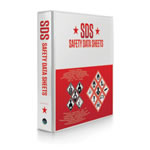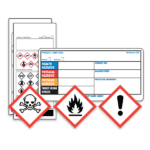
The Crucial Role of Safety Data Sheets in the Workplace
Safety is paramount in any workplace where chemicals are used. One of the most important tools for ensuring that employees, contractors, and visitors are protected from hazardous materials is the Safety Data Sheet (SDS). These documents, which provide vital information on the properties of chemicals, are essential in maintaining a safe working environment. Let’s dive into what SDSs are, their role in workplace safety, and why they should never be overlooked.
What is a Safety Data Sheet (SDS)? An SDS is a document that provides detailed information about a chemical product’s properties, hazards, handling precautions, and emergency response measures. It is typically structured in 16 standardized sections, ensuring that all critical information is readily available and easy to understand.
The format of the SDS is globally recognized and follows standards set by organizations such as OSHA (Occupational Safety and Health Administration) in the United States and WHMIS (Workplace Hazardous Materials Information System) in Canada. The SDS is designed for use by employees, emergency responders, and safety managers to assess and mitigate risks posed by chemicals in the workplace.
What are the key components of an SDS? Each SDS is divided into 16 sections, each providing specific details:
- Identification: Includes product name, recommended uses, and supplier contact information.
- Hazard Identification: Describes the potential hazards of the substance, including health, fire, and environmental risks.
- Composition/Information on Ingredients: Lists the ingredients in the product and their concentrations.
- First-Aid Measures: Provides instructions on how to respond in case of exposure or an accident.
- Fire-Fighting Measures: Details the appropriate firefighting techniques, suitable extinguishing agents, and special hazards.
- Accidental Release Measures: Describes how to contain and clean up spills or leaks.
- Handling and Storage: Offers guidance on the safe storage and handling of the chemical.
- Exposure Controls/Personal Protection: Specifies recommended exposure limits and the necessary protective equipment.
- Physical and Chemical Properties: Lists characteristics like boiling point, flashpoint, and solubility.
- Stability and Reactivity: Covers the chemical’s stability and its potential for dangerous reactions.
- Toxicological Information: Provides data on potential health effects, including symptoms of exposure.
- Ecological Information: Discusses the environmental impact and risks of the chemical.
- Disposal Considerations: Outlines safe disposal methods.
- Transport Information: Lists shipping requirements, including appropriate shipping names and hazard class.
- Regulatory Information: Summarizes relevant safety, health, and environmental regulations.
- Other Information: Includes additional details, such as the date of the SDS or special instructions.
One of the most critical functions of an SDS is to identify potential hazards associated with a chemical. The SDS provides clear, specific details that help workers understand the risks they may face, whether the chemical is flammable, toxic, corrosive, or reactive. Employees can take the proper precautions to prevent accidents and injuries by knowing what risks are present.
The SDS becomes a crucial resource in the event of an accident. It provides detailed first-aid instructions and information on how to handle exposures, spills, or fires. This readily available information ensures that workers can respond quickly and effectively in emergencies, potentially saving lives and preventing further harm.
The SDS offers guidelines on how to handle and store chemicals safely. Proper storage conditions, such as temperature or ventilation requirements, are often outlined. By following these instructions, workers can avoid accidents caused by improper storage or handling, which could lead to spills, fires, or chemical reactions.
In many countries, employers are legally required to provide SDSs for all hazardous chemicals in the workplace. These regulations, such as OSHA’s Hazard Communication Standard (HCS) in the U.S. or WHMIS in Canada, mandate that employers educate workers on the chemicals they are working with. SDSs are essential for compliance and can protect employers from legal and financial consequences in case of a workplace incident.
SDSs help foster a culture of safety in the workplace. Employers can reduce the likelihood of exposure and long-term health issues by ensuring that workers are aware of the chemicals they’re working with, the associated risks, and the necessary protective measures. This is particularly important in manufacturing, construction, laboratories, and healthcare, where workers are routinely exposed to hazardous substances.
For SDSs to be effective, they must be easily accessible to all workers. Here are a few tips for ensuring this:
- Digital Access: Implementing a digital system that allows employees to search and access SDSs quickly is efficient, especially in large workplaces.
- Physical Copies: In some cases, physical copies of the SDS might need to be kept in designated locations where they are easily accessible in case of emergency.
- Training: Employees should be trained to read and interpret SDSs. Regular training ensures everyone knows how to access and use the information provided.
Safety Data Sheets are a cornerstone of workplace safety, providing essential information that helps prevent accidents, ensure regulatory compliance, and protect the health and well-being of employees. By understanding and effectively utilizing SDSs, companies can create safer work environments, reduce the risk of hazardous incidents, and foster a culture of awareness and preparedness. If you haven’t already, ensure that your workplace has a comprehensive system for managing SDSs — it’s not just a best practice; it’s a vital part of maintaining safety in the workplace.
Remember, we are in a transition. Your SDS must be updated. The WHMIS deadline is fast approaching, with the OSHA deadline on its heels. ICC Compliance Center has a team of full-time Regulatory Experts who have years of experience and are certified/recognized in their field of expertise. Contact us about authoring, reformatting, updating, and translating your SDSs. Ask us your tough questions by calling 888.442.9628 (USA) or 888.977.4834 (Canada).
Stay up to date and sign up for our newsletter!
We have all the products, services and training you need to ensure your staff is properly trained and informed.
 SDS Services SDS Services |
 GHS/OSHA/WHMIS GHS/OSHA/WHMISLabels |
 OSHA/WHMIS/GHS OSHA/WHMIS/GHSTraining Courses |






 ICC USA
ICC USA ICC Canada
ICC Canada